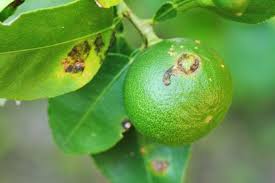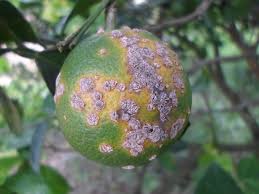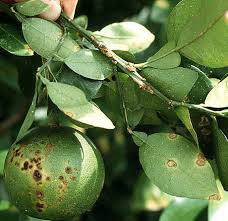Citrus canker, scientifically known as Xanthomonas axonopodis subsp. citri, is a bacterial disease that poses a significant threat to citrus trees worldwide. This infectious disease primarily affects citrus species, including oranges, lemons, and grapefruits, and can result in severe economic losses for citrus-producing regions.
The bacteria responsible for citrus canker thrive in warm and humid conditions, making many citrus-growing areas susceptible to its spread. The pathogen enters the plant through natural openings, such as stomata, or wounds caused by wind, rain, or insects. Once inside, it multiplies rapidly, leading to the formation of lesions on leaves, fruits, and stems.
The symptoms of citrus canker are easily recognizable. Circular, raised lesions with water-soaked margins appear on the leaves and fruit, giving the affected areas a blister-like appearance. These lesions later develop a corky texture, causing premature fruit drop and rendering the fruits unsuitable for the market.
The economic impact of citrus canker extends beyond the immediate loss of infected crops. Infested areas often face strict quarantine measures to prevent the disease’s further spread, disrupting citrus trade and affecting local economies. The threat of citrus canker has prompted extensive research into preventive measures and management strategies.
Control measures for citrus canker involve a combination of cultural practices, such as pruning infected branches and removing affected debris, and the application of copper-based sprays to limit bacterial growth. Additionally, early detection and rapid response are crucial in preventing the disease from spreading to new areas.
Efforts to develop citrus varieties resistant to canker are ongoing, aiming to provide a long-term solution to this persistent threat. Researchers are employing advanced biotechnological methods to enhance citrus plants’ natural resistance mechanisms, offering hope for sustainable citrus cultivation.
The global citrus industry faces ongoing challenges due to citrus canker, highlighting the need for international collaboration in research and disease management. Strict adherence to quarantine regulations, improved surveillance, and public awareness campaigns are essential components of a comprehensive strategy to curb the disease’s impact.
However, citrus canker remains a formidable adversary for citrus growers worldwide, affecting both the quality and quantity of citrus crops. Understanding the biology of the pathogen, implementing effective control measures, and investing in resistant citrus varieties are crucial steps towards ensuring the resilience of the citrus industry in the face of this persistent threat.
Read Also: Are Honey Bees Aggressive?
Plants Affected by Citrus Canker (Xanthomonas axonopodis subsp. citri)

Citrus canker primarily affects various citrus plants, causing detrimental consequences to their growth and productivity. Common citrus species susceptible to this bacterial disease include:
1. Sweet Oranges (Citrus sinensis): Sweet oranges, known for their juicy and flavorful fruit, are highly vulnerable to citrus canker. The disease manifests as characteristic lesions on leaves, stems, and fruit, compromising the overall health of the orange trees.
2. Grapefruits (Citrus paradisi): Grapefruit trees also fall prey to citrus canker, with infected fruit developing lesions that reduce their marketability. The disease can lead to premature fruit drop, impacting the grapefruit yield.
3. Lemons (Citrus limon): Lemon trees are not immune to citrus canker, experiencing similar symptoms of raised lesions on leaves and fruit. The blemished appearance and compromised quality of lemons make them less desirable for consumption and commercial use.
4. Limes (Citrus aurantiifolia): Lime trees are susceptible to citrus canker, and the disease can negatively impact the production of limes. Lesions on leaves and fruit diminish the overall vitality of lime trees and reduce the quality of the harvested fruit.
5. Mandarins (Citrus reticulata): Mandarins, including varieties like clementines and tangerines, can be affected by citrus canker. The disease poses a threat to the quality of mandarin fruit, leading to aesthetic and economic losses for growers.
It’s important to note that citrus canker can affect various cultivars within these species, and efforts to manage and prevent its spread are crucial for maintaining the health and productivity of citrus orchards.
Damages Caused by Citrus Canker

Citrus canker inflicts significant damages on citrus trees, resulting in both immediate and long-term consequences for affected orchards. The key damages caused by citrus canker include:
1. Reduced Fruit Quality: Citrus canker leads to the formation of characteristic lesions on the fruit’s surface, rendering it visually unappealing and reducing its market value. Consumers often prefer blemish-free fruit, and affected citrus may face rejection in the market.
2. Premature Fruit Drop: Infected citrus trees often experience premature fruit drop as a consequence of the disease. This not only reduces the overall yield but also hampers the economic viability of citrus orchards.
3. Stunted Growth and Defoliation: Citrus canker weakens the affected trees, causing stunted growth and defoliation. The formation of lesions on leaves disrupts the photosynthetic process, compromising the tree’s ability to generate energy and nutrients.
4. Impact on Citrus Industry: The economic impact of citrus canker extends beyond individual orchards. Regions grappling with widespread citrus canker outbreaks may face quarantine measures, restricting the movement of citrus products. This can disrupt local economies heavily dependent on citrus cultivation and trade.
5. Increased Management Costs: Citrus canker necessitates additional management efforts and costs for growers. Implementing control measures such as pruning infected branches, applying copper-based sprays, and monitoring for disease spread require financial investments and labor.
6. Trade Restrictions: Countries or regions dealing with citrus canker outbreaks may face trade restrictions on citrus products. Strict quarantine measures are often imposed to prevent the disease from spreading to non-infested areas, affecting international trade and commerce.
7. Long-term Impact on Tree Health: Chronic infections can have a lasting impact on the overall health of citrus trees. Weakened trees are more susceptible to other diseases and environmental stresses, potentially leading to increased mortality rates in severe cases.
8. Challenges to Sustainable Citrus Cultivation: Citrus canker poses ongoing challenges to sustainable citrus cultivation. Efforts to develop resistant citrus varieties and effective control strategies are essential for ensuring the long-term viability of the citrus industry in affected regions.
Additionally, the damages caused by citrus canker extend beyond the visual symptoms on the fruit and leaves, impacting the economic, agricultural, and environmental aspects of citrus cultivation. Vigilant management and preventive measures are crucial for mitigating these damages and sustaining healthy citrus orchards.
Read Also: Honey Bees in Winter
Control and Preventive Measures

Implementing effective control and preventive measures is crucial to managing and mitigating the impact of citrus canker. These strategies aim to minimize the spread of the disease and protect citrus orchards. Key measures include:
1. Pruning and Removal of Infected Material: Prompt identification and removal of infected plant material, such as leaves, fruit, and branches, can help prevent the spread of citrus canker within the orchard. Regular pruning practices reduce the bacterial population and limit disease progression.
2. Copper-Based Sprays: Applying copper-based sprays to citrus trees is a common practice to control citrus canker. Copper acts as a bactericide, suppressing bacterial growth and reducing the severity of the disease. Regular applications during the growing season are often recommended.
3. Biological Control Agents: Introducing beneficial microorganisms or predators that target the citrus canker bacterium can be part of an integrated pest management strategy. This biological control approach aims to naturally suppress the population of the pathogen.
4. Quarantine Measures: Implementing strict quarantine measures in areas with confirmed citrus canker outbreaks is essential to prevent the disease from spreading to unaffected regions. This includes restricting the movement of citrus plants, fruit, and equipment that may carry the bacteria.
5. Citrus Varieties Resistant to Canker: Developing and planting citrus varieties with inherent resistance to citrus canker is a long-term solution. Research efforts focus on breeding cultivars with enhanced natural defenses against the pathogen.
6. Surveillance and Early Detection: Regular monitoring of citrus orchards for symptoms of citrus canker enables early detection and intervention. Early identification allows for timely implementation of control measures, reducing the likelihood of widespread infection.
7. Public Awareness and Education: Educating citrus growers, industry stakeholders, and the public about the symptoms of citrus canker, preventive measures, and the importance of compliance with quarantine regulations is crucial. Increased awareness contributes to the collective effort to contain and manage the disease.
8. Research and Development: Continued research into the biology of the citrus canker bacterium, innovative control methods, and the development of resistant citrus varieties is essential. This ongoing scientific effort aims to improve the effectiveness of control measures and enhance the resilience of citrus crops.
9. Integrated Pest Management (IPM): Adopting an integrated approach that combines cultural, biological, and chemical control measures is key to managing citrus canker sustainably. IPM emphasizes minimizing environmental impact while effectively controlling the disease.
10. Regulatory Compliance: Strict adherence to regulations and guidelines established by agricultural authorities is crucial. Growers should cooperate with regulatory bodies to enforce control measures and prevent the unintentional spread of citrus canker.
Additionally, a multi-faceted approach involving pruning, chemical applications, biological control, and strict adherence to quarantine measures is necessary to control and prevent the spread of citrus canker. These measures collectively contribute to the overall health and sustainability of citrus orchards in the face of this bacterial threat.
Frequently Asked Questions (FAQs) About Citrus Canker (Xanthomonas axonopodis subsp. citri)
Q1: What is citrus canker?
A1: Citrus canker is a bacterial disease caused by Xanthomonas axonopodis subsp. citri that affects citrus plants, leading to the development of characteristic lesions on leaves, fruit, and stems.
Q2: How does citrus canker spread?
A2: Citrus canker primarily spreads through wind-driven rain, insects, and contaminated tools or equipment. The bacteria enter the plant through natural openings or wounds, initiating infection.
Q3: What are the symptoms of citrus canker?
A3: Symptoms include raised lesions on leaves, fruit, and stems with water-soaked margins. These lesions later become corky, affecting the appearance and quality of citrus crops.
Q4: Which citrus species are susceptible to citrus canker?
A4: Common citrus species affected include sweet oranges (Citrus sinensis), grapefruits (Citrus paradisi), lemons (Citrus limon), limes (Citrus aurantiifolia), and mandarins (Citrus reticulata).
Q5: Can citrus canker be controlled?
A5: Yes, control measures include pruning infected material, applying copper-based sprays, introducing biological control agents, and implementing quarantine measures. Early detection and surveillance are crucial for effective control.
Q6: How does copper-based spray help in controlling citrus canker?
A6: Copper acts as a bactericide, suppressing bacterial growth. Regular applications of copper-based sprays on citrus trees help reduce the severity of citrus canker.
Q7: Are there citrus varieties resistant to citrus canker?
A7: Research is ongoing to develop citrus varieties with inherent resistance to citrus canker. Breeding programs aim to enhance natural defenses against the pathogen.
Q8: Why is quarantine important in citrus canker management?
A8: Quarantine measures help prevent the spread of citrus canker to unaffected regions. They involve restricting the movement of citrus plants, fruit, and equipment that may carry the bacteria.
Q9: How can growers detect citrus canker early?
A9: Regular monitoring of citrus orchards for symptoms, such as lesions on leaves and fruit, enables early detection. Vigilant growers can then implement timely control measures.
Q10: What can the public do to help prevent citrus canker spread?
A10: Public awareness is crucial. Education about the symptoms, adherence to quarantine regulations, and reporting suspected cases contribute to collective efforts in containing and managing citrus canker.
Read Also: What is Fitness? Types, Benefits You Should Know
